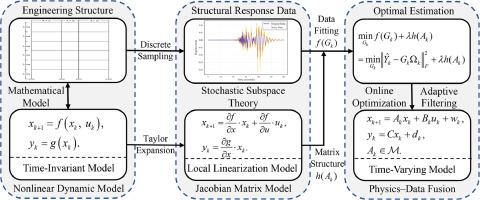Adaptive physics-informed system modeling with control for nonlinear structural system estimation
IF 7.3
1区 工程技术
Q1 ENGINEERING, MULTIDISCIPLINARY
Computer Methods in Applied Mechanics and Engineering
Pub Date : 2025-09-01
DOI:10.1016/j.cma.2025.118330
引用次数: 0
Abstract
Accurately capturing the nonlinear dynamic behavior of structures remains a significant challenge in mechanics and engineering. Traditional physics-based models and data-driven approaches often struggle to simultaneously ensure model interpretability, noise robustness, and estimation optimality. To address this issue, this paper proposes an Adaptive Physics-Informed System Modeling with Control (APSMC) framework. By integrating Kalman filter-based state estimation with physics-constrained proximal gradient optimization, the framework adaptively updates time-varying state-space model parameters while processing real-time input–output data under white noise disturbances. Theoretically, this process is equivalent to real-time tracking of the Jacobian matrix of a nonlinear dynamical system. Within this framework, we leverage the theoretical foundation of stochastic subspace identification to demonstrate that, as observational data accumulates, the APSMC algorithm yields state-space model estimates that converge to the theoretically optimal solution. The effectiveness of the proposed framework is validated through numerical simulations of a Duffing oscillator and the seismic response of a frame structure, as well as experimental tests on a scaled bridge model and real wind turbine health monitoring data. Experimental results show that, under noisy conditions, APSMC successfully predicts 19 consecutive 10-second time series using only a single initial 10-second segment for model updating, achieving a minimum normalized mean square error (NMSE) of 0.398 %. Furthermore, APSMC achieves the best performance among classical time-domain algorithms on measured wind turbine acceleration data. These findings demonstrate that the APSMC framework not only offers superior online identification and denoising performance but also provides a reliable foundation for downstream applications such as structural health monitoring, real-time control, adaptive filtering, and system identification. An open-source Python implementation is available on GitHub.

非线性结构系统估计的自适应物理信息系统建模与控制
准确地捕捉结构的非线性动力行为仍然是力学和工程中的一个重大挑战。传统的基于物理的模型和数据驱动的方法往往难以同时确保模型的可解释性、噪声鲁棒性和估计的最优性。为了解决这一问题,本文提出了一种自适应物理信息系统建模与控制(APSMC)框架。该框架将基于卡尔曼滤波的状态估计与物理约束的近端梯度优化相结合,在处理白噪声干扰下的实时输入输出数据的同时,自适应更新时变状态空间模型参数。从理论上讲,这个过程相当于一个非线性动力系统的雅可比矩阵的实时跟踪。在这个框架内,我们利用随机子空间识别的理论基础来证明,随着观测数据的积累,APSMC算法产生的状态空间模型估计收敛于理论上的最优解。通过Duffing振子的数值模拟和框架结构的地震响应,以及对桥梁模型和实际风力机健康监测数据的实验测试,验证了该框架的有效性。实验结果表明,在噪声条件下,APSMC仅使用单个初始10秒片段即可成功预测19个连续的10秒时间序列进行模型更新,实现了最小归一化均方误差(NMSE) 0.398%。此外,在经典时域算法中,APSMC在风力机实测加速度数据上的性能最好。这些研究结果表明,APSMC框架不仅具有良好的在线识别和去噪性能,而且为结构健康监测、实时控制、自适应滤波和系统识别等下游应用提供了可靠的基础。在GitHub上可以找到一个开源的Python实现。
本文章由计算机程序翻译,如有差异,请以英文原文为准。
求助全文
约1分钟内获得全文
求助全文
来源期刊
CiteScore
12.70
自引率
15.30%
发文量
719
审稿时长
44 days
期刊介绍:
Computer Methods in Applied Mechanics and Engineering stands as a cornerstone in the realm of computational science and engineering. With a history spanning over five decades, the journal has been a key platform for disseminating papers on advanced mathematical modeling and numerical solutions. Interdisciplinary in nature, these contributions encompass mechanics, mathematics, computer science, and various scientific disciplines. The journal welcomes a broad range of computational methods addressing the simulation, analysis, and design of complex physical problems, making it a vital resource for researchers in the field.

 求助内容:
求助内容: 应助结果提醒方式:
应助结果提醒方式:


